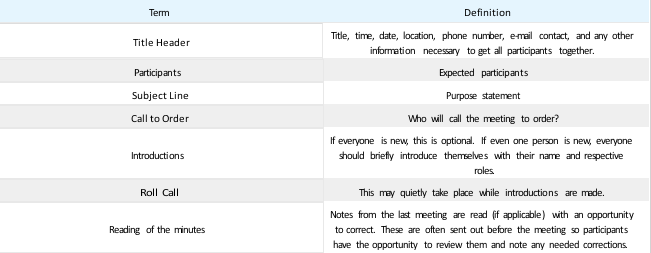Learning Objectives
Discuss meetings and their role in business communication.
Describe the main parts of an agenda.
Discuss several strategies for effective meetings.
A meeting is a group communication activity centered on a defined agenda, held at a set time for an established duration. Meetings can be effective, ineffective, or a complete waste of time. If time is money and effectiveness and efficiency are your goals, then if you arrange, lead, or participate in a meeting, you want it to be worth your time (Mosvick, R. K., 1996).

Figure 15.3.1: Image by StartupStockPhotos from Pixabay
Meetings can occur face-to-face, but businesses and industries increasingly turn to teleconferencing and videoconferencing options as the technology improves participation costs, including time and travel costs. Regardless of how you come together as a team, group, or committee, you must define your purpose in advance with an agenda (Deal, T., and Kennedy, A., 1982). The main parts of an agenda for a standard meeting are listed in Table 15.3.1.


Strategies for Effective Meetings
You want an efficient and effective meeting, but recognize that group communication by definition can be chaotic and unpredictable. To stay on track, consider the following strategies:
- Send out the last meeting’s minutes one week before the next meeting.
- Send out the agenda for the current meeting at least one week in advance.
- Send out reminders for the meeting the day before and the day of the meeting.
- Schedule the meeting in Outlook or a similar program so everyone receives a reminder.
- Start and end your meetings on time.
- Make sure the participants know their roles and requirements before the meeting.
- Make sure all participants know one another before the discussion starts.
- Formal communication styles and references to the agenda can help reinforce the time frame and tasks.
- Follow Robert’s Rules of Order when applicable, or at least be familiar with them.
- Ensure notes taken at the meeting are legible and can be converted to minutes for distribution later.
- Keep the discussion on track. If you are the chair or leader of a meeting, don’t hesitate to restate a point to interject and redirect the attention to the next item on the agenda.
- If you are the chair, clearly distinguish between on-topic discussions and those that are more personal, individual, or off-topic.
- Communicate your respect and appreciation for everyone’s time and effort.
- Communicate the time, date, and location or means of contact for the next meeting.
Key Takeaway
Good planning and preparation make meetings productive, engaging, and efficient.
Exercises
Create a sample agenda for a business meeting to discuss the quarterly sales report and results from the latest marketing campaign. Decide what information is needed, and what position might normally be expected to produce that information. Note in your agenda all the elements listed above, even if some elements (such as “good of the order”) only serve as a placeholder for the discussion that will take place.
Write a brief description of a meeting you recently attended and indicate one way you perceived it as effective. Compare with classmates.
Mosvick, R. K. (1996). We’ve got to start meeting like this: A guide to successful meeting management. New York, NY: Park Avenue Productions.
Deal, T., & Kennedy, A. (1982). Corporate cultures: The rites and rituals of corporate life. Reading, MA: Addison-Wesley Publishing Company, Inc.
This page titled 15.3: Meetings is shared under a CC BY-NC-SA 3.0 license and was authored, remixed, and/or curated by Anonymous (LibreTexts Staff), from which source content was edited to the style and standards of the Pressbook platform licensed under a Creative Commons Attribution-NonCommercial-ShareAlike 4.0 International License by Brandi Schur.

